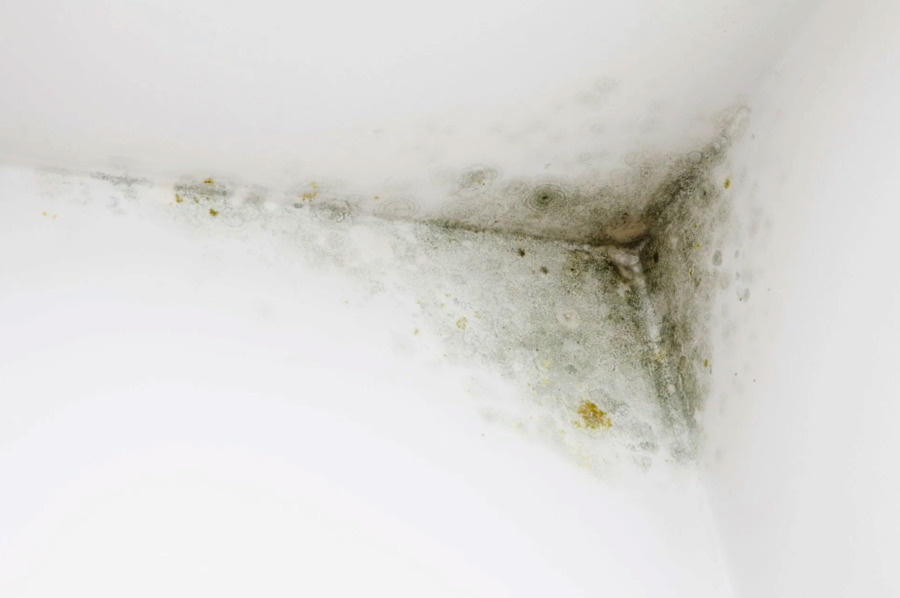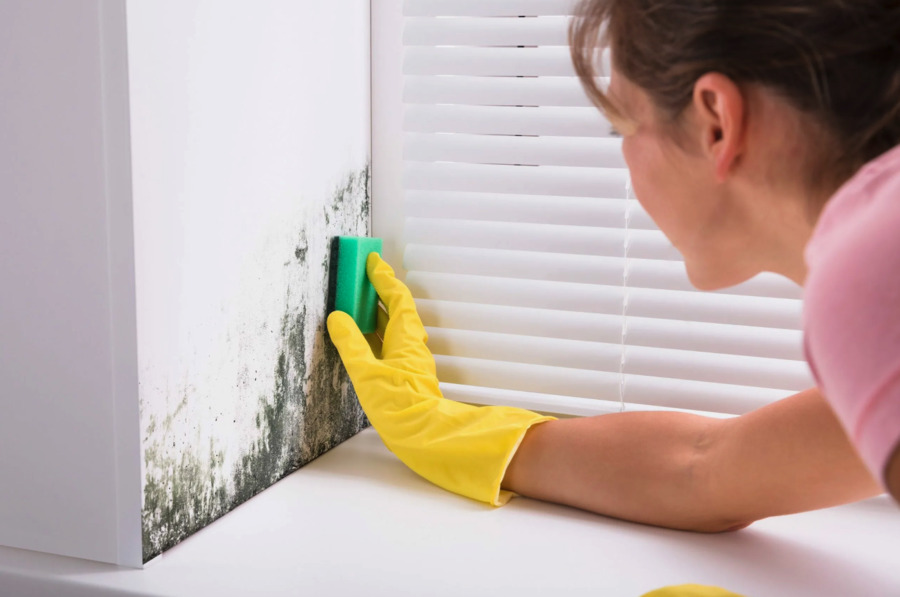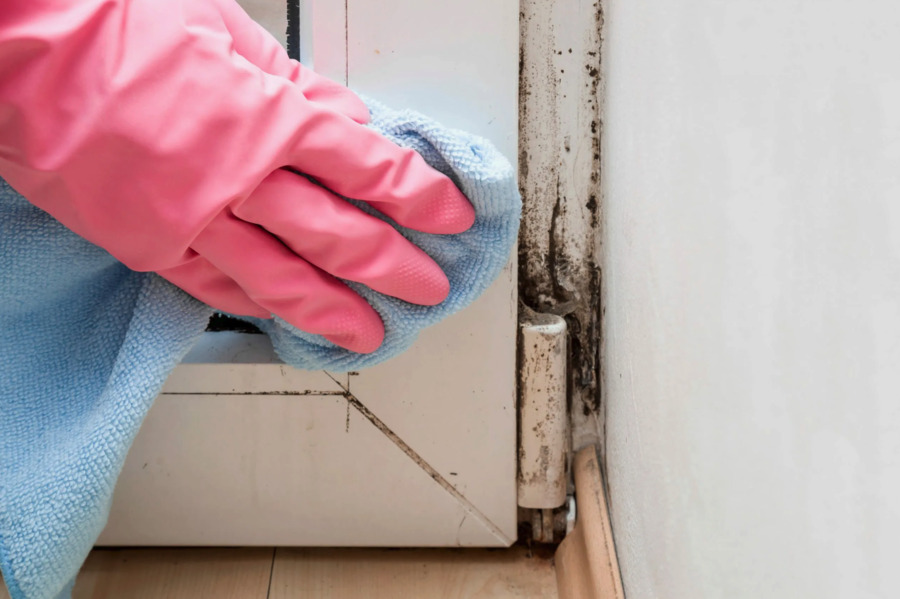Mold represents a diverse group of fungal species that thrive in moist environments. Ubiquitous in nature, molds can appear in a spectrum of colors, including black, white, orange, green, or purple, and are adaptable to both indoor and outdoor settings. These fungi reproduce through tiny spores that float through the air, often undetected by the naked eye. In indoor environments, mold can be particularly troublesome, not only for its potential to degrade various household materials such as wood, carpet, and drywall but also for the serious health risks it poses to residents. Mold’s primary role in nature is to break down dead organic matter, yet when it grows unchecked within living spaces, it can lead to significant health concerns and substantial damage to building structures.

Common Types of Mold in Living Spaces
Mold diversity in residential areas can vary widely, each type bringing specific challenges and health risks:
Stachybotrys (Black Mold)
Often referred to as “black mold,” Stachybotrys chartarum is notorious for its severe impact on indoor air quality. Thriving on moisture-soaked materials rich in cellulose, this mold initially presents as small black spots and can grow to cover large areas if not addressed. Known for producing mycotoxins, Stachybotrys can cause a range of health issues, from mild irritation to serious respiratory distress, and is particularly dangerous for young children and the elderly.
Mucormycetes
Typically found in soil and plant debris, Mucormycetes can enter homes on shoes, pets, or through open windows, particularly during the warmer months. This mold tends to colonize quickly on food items and inside damp HVAC systems, posing significant allergy and asthma triggers.
Alternaria
As one of the most common forms of mold found in the environment, Alternaria can cause problems when it takes hold in damp areas within homes, such as under sinks and around bathtubs. It can trigger allergic reactions and exacerbate asthma symptoms in sensitive individuals.
Aspergillus
This mold is a ubiquitous presence in many households, capable of growing on a wide array of surfaces where moisture accumulates. With numerous species falling under the Aspergillus umbrella, some forms can be harmless while others pose serious health risks, particularly in immunocompromised individuals.
Aureobasidium pullulans
Commonly found on damp surfaces behind wallpaper and on wooden or painted surfaces, Aureobasidium can cause allergic reactions and irritate the skin on contact, making it a concern during renovation or cleanup efforts.
Acremonium
Found in humid environments like HVAC systems and window sealants, Acremonium starts as a moist mold but can become powdery over time. Exposure to its spores can lead to a range of health issues, including respiratory difficulties and more severe immune system responses.
Chaetomium
Often found in water-damaged homes and buildings, Chaetomium is known for its musty odor and can be an indicator of water issues. It is particularly concerning because of its potential to cause allergic reactions and other respiratory symptoms.
Cladosporium
This type of mold can thrive in both warm and cold conditions typically found on fabrics and carpets and under sinks where moisture levels are higher. Cladosporium is known for triggering respiratory problems.
Ulocladium
Found in water-logged environments, Ulocladium resembles black mold and is often associated with severe water damage. Like many molds, it can exacerbate allergies and asthma.
Fusarium
Able to grow and spread at lower temperatures, Fusarium can be found throughout a home, particularly in areas with organic debris. Some species are known for their toxicity and can cause serious health issues if not properly managed.
Penicillium
Often associated with antibiotics, Penicillium is another common indoor mold that can present health risks. It is known for causing allergies and respiratory issues and in severe cases, can lead to chronic sinus infections.
Trichoderma
Favoring damp conditions, Trichoderma can be particularly problematic in homes with high humidity, leading to respiratory and bronchial infections.
Mold Hotspots in Homes
Identifying common mold growth hotspots can help in early detection and prevention. Areas prone to high moisture, such as bathrooms, kitchens, and basements, are typical mold hotspots. Leaking pipes, condensation, and poor ventilation can exacerbate mold growth, making regular maintenance and moisture control critical in these areas.
The Importance of Мold Control
Controlling mold is crucial due to its potential to cause health issues. Extended exposure to mold can lead to symptoms such as coughing, runny nose, headaches, and skin irritation because mold spores, once airborne, can be easily inhaled into the lungs, particularly affecting those with compromised immune systems.
Children and individuals with weakened immune systems are particularly vulnerable to mold-related illnesses.
For effective mold removal, especially in cases where the infestation is extensive, it is advisable to seek the assistance of professional remediation services rather than attempting to address the issue on your own.
How to Fight Mold in Your Living Spaces
Effectively combating mold involves several key strategies:
– Reduce Humidity: Aim to keep indoor humidity levels below 60%, as higher humidity fosters mold growth.
– Improve Ventilation: Enhanced airflow can help keep moisture levels down. Use exhaust fans in bathrooms and kitchens, and open windows when weather permits.
– Fix Leaks: Address plumbing issues and other sources of water ingress promptly to minimize moisture accumulation.
– Clean and Dry: After any water damage, it’s crucial to clean and dry all affected areas thoroughly to prevent mold colonization.
– Professional Remediation: In cases of extensive mold contamination, professional mold remediation services like those offered by Judux are vital to ensure safe and effective mold removal.
Trust Judux for Expert Mold Remediation Services in Dubai
Judux stands as a dependable provider of hygiene solutions in Dubai, specializing in comprehensive maintenance and cleaning services. As your trusted partner in mold mitigation, Judux offers professional expertise to ensure your environment is safe and clean. Simply rely on the experts at Judux to handle your mold concerns effectively!
By understanding the different types of mold and their preferred conditions, homeowners can take proactive measures to maintain a healthy living environment. Professional intervention is recommended to eradicate mold and thoroughly prevent future growth.

Soccer lover, tattoo addict, music blogger, Bauhaus fan and fullstack designer. Operating at the crossroads of design and intellectual purity to save the world from bad design. Check me out on Dribbble or Medium.




